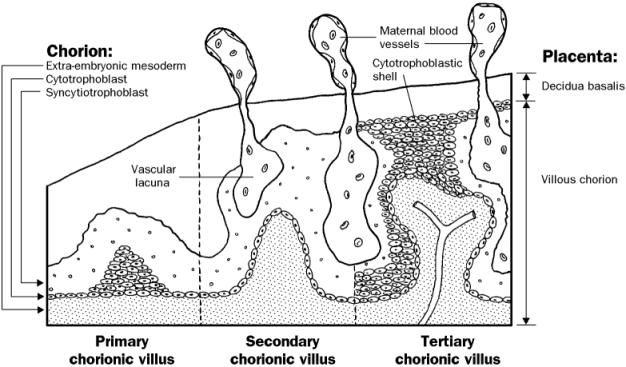Artlabeling Activity Extraembryonic Membranes and Placenta Formation Week 10
Placenta
The placenta is a fetomaternal organ. The fetal portion of the placenta is known as the villous chorion. The maternal portion is known as the decidua basalis. The two portions are held together past anchoring villi that are anchored to the decidua basalis by the cytotrophoblastic beat out.
Decidua
The endometrium (lining of the uterus) of the mother is known as the decidua (�cast off�), consisting of three regions named by location.
Table 7 - Regions of the Decidua
| Region | Clarification |
| Decidua basalis | Region betwixt the blastocyst and the myometrium |
| Decidua capsularis | Endometrium that covers the implanted blastocyst |
| Decidua parietalis | All the remaining endometrium |
As the embryo enlarges, the decidua capsularis becomes stretched and smooth. Somewhen the decidua capsularis merges with the decidua parietalis, obliterating the uterine cavity.
Placental Membrane
Office
The placental membrane separates maternal claret from fetal claret. The fetal office of the placenta is known every bit the chorion. The maternal component of the placenta is known equally the decidua basalis.
� Oxygen and nutrients in the maternal claret in the intervillous spaces diffuse through the walls of the villi and enter the fetal capillaries.
� Carbon dioxide and waste products diffuse from claret in the fetal capillaries through the walls of the villi to the maternal blood in the intervillous spaces.
The Placenta
Although the placental membrane is frequently referred to every bit the placental barrier, many substances, both helpful and harmful, tin can cross it to impact the developing embryo.
Construction
� Primary chorionic villi are solid outgrowths of cytotrophoblast that protrude into the syncytiotrophoblast.
� Secondary chorionic villi have a core of loose connective tissue, which grows into the primary villi almost the 3rd calendar week of development.
� Tertiary chorionic villi contain embryonic blood vessels that develop from mesenchymal cells in the loose connective tissue core. These blood vessels connect up with vessels that develop in the chorion and connecting stalk and brainstorm to broadcast embryonic claret about the 3rd week of development.

Figure four - Construction of placenta and chorionic villi
Table 8 - Substances that Cross the Placental Membrane
| Substances | Examples |
| Beneficial | |
| Gases | Oxygen, carbon dioxide |
| Nutrients | Glucose, amino acids, free fatty acids, vitamins |
| Metabolites | Carbon dioxide, urea, uric acid, bilirubin, creatine, creatinine |
| Electrolytes | Na+, K+, Cl-, Catwo+, PO4 2- |
| Erythrocytes | Fetal and maternal both (a few) |
| Maternal serum proteins | Serum albumin, some protein hormones (thyroxin, insulin) |
| Steroid hormones | Cortisol, estrogen (unconjugated only) |
| Immunoglobins | IgG (confers fetal passive immunity) |
| Harmful | |
| Poisonous gases | Carbon monoxide |
| Infectious agents | Viruses (HIV, cytomegalovirus, rubella, Coxsackie, variola, varicella, measles, poliomyelitis), bacteria (tuberculosis, Treponema), and protozoa (Toxoplasma) |
| Drugs | Cocaine, alcohol, caffeine, nicotine, warfarin, trimethadione, phenytoin, tetracycline, cancer chemotherapeutic agents, anesthetics, sedatives, analgesics |
| Immunoglobins | Anti-Rh antibodies |
Amniotic Fluid
Amniotic fluid has three main functions: it protects the fetus physically, it provides room for fetal movements, and helps to regulate fetal body temperature. Amniotic fluid is produced by dialysis of maternal and fetal blood through blood vessels in the placenta. Later, product of fetal urine contributes to the volume of amniotic fluid and fetal swallowing reduces information technology. The h2o content of amniotic fluid turns over every three hours.
Umbilical String
The umbilical cord is a composite structure formed past contributions from:
� Fetal connecting (body) stalk
� Yolk sac
� Amnion
The umbilical cord contains the right and left umbilical arteries, the left umbilical vein, and mucous connective tissue. Presence of only i umbilical artery may suggest the presence of cardiovascular anomalies.
Fetal Circulation
Fetal circulation involves iii circulatory shunts: the ductus venosus, which allows blood from the placenta to bypass the liver, and the ductus arteriosus and foramen ovale, which together let claret to bypass the developing lungs. Refer to the section on changes at birth for more information on the fates of these structures.
Clinical Correlations
Multiple Pregnancy
Dizygotic twins are derived from two zygotes that were fertilized independently (i.e., 2 oocytes and 2 spermatozoa). Consequently, they are associated with two amnions, two chorions, and two placentas, which may (65%) or may not (35%) be fused. Dizygotic twins are only as closely genetically related every bit any two siblings.
Monozygotic twins (30%) are derived from one zygote that splits into two parts. This blazon of twins normally has ii amnions, one chorion, and one placenta. If the embryo splits early in the 2d calendar week after the amniotic cavity has formed, the twins will have one amnion, one chorion, and i placenta. Monozygotic twins are genetically identical, simply may have physical differences due to differing developmental environments (e.1000., unequal division of placental circulation).
Placenta Previa
The fetus implants in such a way that the placenta or fetal claret vessels grow to cake the internal bone of the uterus. Meet implantation.
Erythroblastosis Fetalis
Some erythrocytes produced in the fetus routinely escape into the mother�southward systemic apportionment. When fetal erythrocytes are Rh-positive but the mother is Rh-negative, the mother�s torso tin can form antibodies to the Rh antigen, which cross the placental bulwark and destroy the fetus. The immunological memory of the mother�s immune arrangement means this trouble is much greater with 2d and subsequent pregnancies.
Oligohydramnios
Deficiency of amniotic fluid (less than 400 ml in belatedly pregnancy). It can effect from renal agenesis considering the fetus is unable to contribute urine to the amniotic fluid volume.
Source: https://www.med.umich.edu/lrc/coursepages/m1/embryology/embryo/06placenta.htm
0 Response to "Artlabeling Activity Extraembryonic Membranes and Placenta Formation Week 10"
Postar um comentário